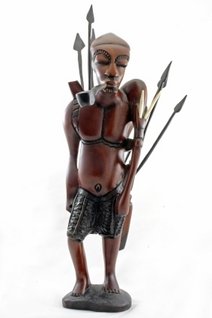|
The 5 Elements of African art are used to describe the aesthetics.
There are 5 elements of African art that are used to describe the aesthetics. Yet African art is so simple and complex at the same time that the elements can't capture its real meaning and purpose. But people need a way to classify and define art and so have narrowed the basic elements of African art to the following:
These concepts underlying African art are what give the art its intrinsic and extrinsic values. There are many regions in Africa and each region has produced its own different art that reflects regional, historical, cultural and religious values and beliefs. African art is so tied to people's everyday life that some art is actually embedded in the very ground they walk upon. It is believed that Lesa, the high god, once visited earth to rearrange it. He left footprints on the Itabwa plain that are preserved to this day in hardened mud.
African art reflects and defines the function and style of different pieces of artwork. African art is varied and includes masks, sculptures, dolls, bowls, jewelry and many other forms. African regional art reflects a particular area's culture by making use of local materials. For example, in Central Africa the arts often represent time and symbolic rites of passage.
In Eastern Africa, the elements of African art include a combination of African, Western and Middle East influences. Status within a group is reflected in the elaborateness of objects used on a daily basis. Northern African art is a rich tapestry of preserved rock paintings, Islamic art and nomadic tribal objects. Western African art includes lost wax castings in bronze, cooper and brass. In Southern Africa, art is almost always everyday objects rather than masks and sculptures.
Trying to describe the 5 elements of African art in a few sentences is like trying to describe the universe in a paragraph. Though art differs by region in its forms and materials, the aesthetic elements provide common ground for understanding the complexity of the art. In Africa, art is intended to portray ideas, beliefs, status and workmanship.
|





